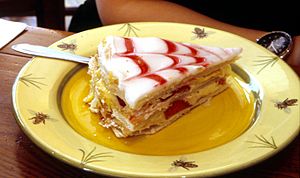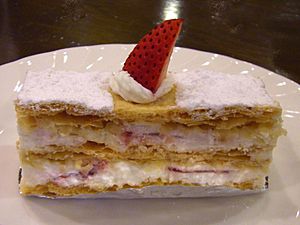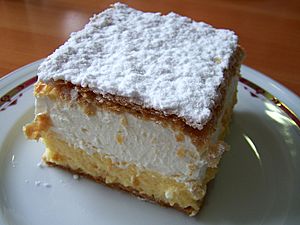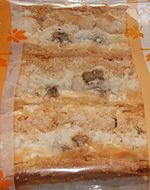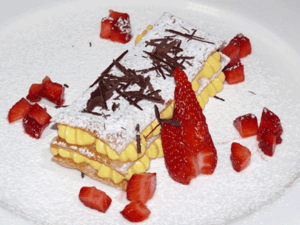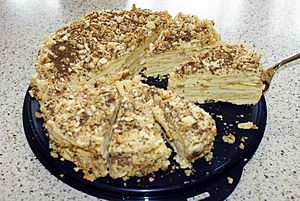- This page was last modified on 3 November 2024, at 07:27. Suggest an edit.
Mille-feuille facts for kids
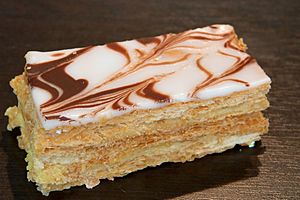
Mille-feuille
|
|
| Alternative names | gâteau de mille-feuilles, vanilla slice or custard slice, Napoleon pastry |
|---|---|
| Type | Pastry, cake |
| Course | Dessert |
| Main ingredients | Puff pastry, custard, powdered sugar |
| Variations | Frangipane, whipped cream |
The mille-feuille ( "thousand-sheets"), vanilla slice or custard slice, similar to but slightly different from the Napoleon, is a pastry whose exact origin is unknown. Its modern form was influenced by improvements made by Marie-Antoine Carême.
Traditionally, a mille-feuille is made up of three layers of puff pastry (pâte feuilletée), alternating with two layers of pastry cream (crème pâtissière). The top pastry layer is also layered with cream and chocolate drizzle, and sometimes cocoa, pastry crumbs, or sliced almonds. Alternatively, the top is glazed with icing or fondant in alternating white (icing) and brown (chocolate) stripes, and combed.
Contents
History
All the elements of the recipe are present in numerous cookbooks since at least the 16th century, but the exact origin of the mille-feuille is unknown.
According to the Oxford Companion to Sugar and Sweets, mille-feuille recipes from 17th century French and 18th century English cookbooks are a precursor to layer cakes.
The earliest mention of the name 'mille-feuille' itself appears in 1733 in an English-language cookbook written by French chef Vincent La Chapelle. The 18th century mille-feuille was served stuffed with jam and marmalade instead of cream.
In French, the first mention of the mille-feuille appears a little later, in 1749, in a cookbook by Menon:
To make a mille-feuille cake, you take puff pastry, make out of it five cakes of equal size, & of the thickness of two coins, in the last one you shall make a hole in the middle in the shape of a Knight's cross, regarding the size you will base yourself on the dish that you will use for service, bake them in the oven. When they are baked & cooled, stack them one on the other, the one with the hole on top, & jams between every cake, [sentence unclear, maybe referring to covering all sides with jam] & ice them everywhere with white icing so that they appear to be a single piece; you can embellish it with some red currant jelly, candied lemon skins & pistachio, you serve them on a plate.
The word 'mille-feuille' is not used again in the recipe books of the 18th century. However, under the reign of Napoleon Bonaparte, several of the fanciest Parisian pastry shops appear to have sold the cake. During the 19th century, all recipes describe the cake as filled with jam, with the exception of the 1876 recipe by Urbain Dubois, where it is served with Bavarian cream.
According to Alan Davidson in the Oxford Companion to Food, the invention of the form (but not of the pastry itself) is usually attributed to Szeged, Hungary, where a caramel-coated mille-feuille is called 'Szegediner Torte'.
Composition
Traditionally, a mille-feuille is made up of three layers of puff pastry, and two layers of crème pâtissière. The top layer is coated with a sprinkling of powdered sugar. In later variations, the top is glazed with icing, in alternating white (icing) and brown (chocolate) strips, and then combed. Today, there are also savory mille-feuille, with cheese and spinach or other savory fillings.
It is often layered with fruits, most commonly strawberry and raspberry.
Variations
According to La Varenne, it was earlier called gâteau de mille-feuilles ("cake of a thousand sheets"), referring to the many layers of pastry. Using traditional puff pastry, made with six folds of three layers, it has 729 layers; with some modern recipes it may have as many as 2,048.
Some scholars argue that the Napoleon is a variant of mille-feuille. Napoleon pastry is made with frangipane instead of custard.
Australia
In Australia, a variant of the mille-feuille is the custard slice, also known as the vanilla slice; colloquially, it is sometimes referred to as a 'snot block' or 'puss pie'. It is made using a gelatin-set crème pâtissière, and in many cases, passionfruit icing. "French Vanilla slice" refers to a product similar to that in the main article. In New Zealand, it is variously known as a 'custard slice', a 'custard square', a 'vanilla slice', or, with passion-fruit icing, a 'passion-fruit slice'.
Balkan countries
A similar local variety is called krempita in Serbia and Bosnia and Herzegovina, kremna rezina or kremšnita in Slovenia and Croatia, and krémeš in Slovakia.
Belgium and the Netherlands
In Belgium and the Netherlands, the tompouce or tompoes is the equivalent pastry. Several variations exist in Belgium, but in the Netherlands it has achieved an almost iconic status, with very little variation seen in form, size, ingredients and colour (always two layers of pastry, nearly always pink glazing, but orange around national festivities). The cartoon character Tom Puss by Marten Toonder is named after the tompouce.

Tompouce on the King's Day in Netherlands
Canada
In Canada, mille-feuille is often named gâteaux Napoléon, or 'Napoleon slice' in English Canada. It is sold either with custard, whipped cream, or both, between three layers of puff pastry; almond paste is the most common filling. A French Canadian method of making a mille-feuille sees it made with graham crackers instead of puff pastry, with pudding replacing the custard layer.
German varieties
In the German speaking part of Switzerland and also in Austria, it is called Cremeschnitte. In Israel it is known by a variation of that name, kremshnit (קרמשניט).
Greece
In Greece, the pastry is called μιλφέιγ, a transcription of the word 'mille-feuille' using the Greek alphabet. The filling between the layers is cream whereas Chantilly cream is used at the top of the pastry.
Hong Kong
In Hong Kong, the 拿破侖 (naa4 po3 leon4, 'Napoleon') is layered with buttercream, meringue and walnuts. In Mainland China, a similar product also marketed as a Napoleon (Chinese: 拿破侖; pinyin: Nápòlún, or more commonly, Chinese: 法式千層酥) varies between regions and individual bakeries, but usually features a top and bottom layer of rough puff pastry, typically made with vegetable shortening rather than butter, and a sponge cake and artificial buttercream filling.
Hungary
In Hungary, it is called krémes. One version, the francia krémes (French Napoleon), is topped with whipped cream and caramel.
Italy
In Italy, the mille-feuille is known as the mille foglie, and contains similar fillings. A savory Italian version consists of puff pastry filled with spinach, cheese or pesto, among other things. Another important distinction of the Italian variety is that it often consists of a layer of puff pastry with layers of sponge cake as well (e.g. from bottom to top, puff pastry, sponge cake strawberries and cream and then puff pastry).
Iran
In Iran, the pastry is called شيرينى ناپلئونى (shirini-e Nâpel'oni, literally "Napoleonic sweet pastry"). It consists of thin puff pastry and often topped with powdered sugar.
Lithuania
In Lithuanian tradition, Napoleon or Napoleonas is quite similar to Russian Napoleon. The recipe varies slightly as Lithuanians add layers of fruit filling such as apricots. It is often associated with weddings or celebrations and often given as gifts.
North Africa
In Tunisia, Morocco, and Algeria, mille-feuille are consumed regularly and are known by their French name.
Philippines
In Philippines, they are called napoleones ( NA-pol-YOH-nes; napoleón in the singular), and are made of two to three layers, with pastry cream or white custard as filling, topped with sugar glaze. It is a popular specialty on Negros Island, especially in Silay City, and can be bought as pasalubong by many who visit the island.
Poland
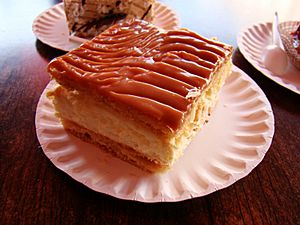
Polish Napoleonka
In Poland, the local variant of the pastry is officially called napoleonka, and less commonly kremówka. It consists of two layers of pastry separated by a thick cream layer. The whole pastry is then covered with powdered sugar.
Russia
Russian literature, a cake named 'Napoleon' (Russian: Наполеон) is first mentioned as early as in the first half of the 19th century. Alexander Bestuzhev explained the emergence of such names by the romantic and historicist spirit of that time. The cake has enjoyed an especially great popularity since the centenary celebration of the Russian victory over Napoleon in the Patriotic War of 1812. During the celebrations in 1812, triangular-shape pastries were sold resembling the bicorne. The many layers of the cake symbolized La Grande Armée. The top is covered by pastry crumbs symbolizing the snow of Russia which helped the Russians defeat Napoleon. Later, the cake became a standard dessert in the Soviet cuisine. Nowadays, the Napoleon remains one of the most popular cakes in Russia and other post-Soviet countries. It typically has more layers than the French archetype, but the same height.
South Africa
In South Africa and Zimbabwe, it is called a 'custard slice'.
Spain
In the Spanish milhojas, the puff pastry is thin and crunchy. They are often far deeper than solely three layers of pastry and can reach up to .5 feet (0.15 m) tall.
Sweden
In Sweden as well as in Finland, the Napoleonbakelse (Napoleon pastry) is a mille-feuille filled with whipped cream, custard, and jam. The top of the pastry is glazed with icing and currant jelly. In Denmark it is called napoleonskage and in Norway napoleonskake, both meaning 'Napoleon cake'.
United Kingdom
In the United Kingdom, the pastry is most often called a 'vanilla slice', 'cream slice', or a 'custard slice', but can, on occasion, be named mille-feuille or 'Napoleon' on branded products. It is common in the UK to only use two slices of pastry with a single, thick layer of filling between them.
Other
In Latin American milhojas, various layers of puff pastry are layered with dulce de leche and confectioner's sugar on top. A Colombian version of milhoja has dulce de leche and melted bocadillo between the layers and is topped with whipped cream and coconut flakes.


